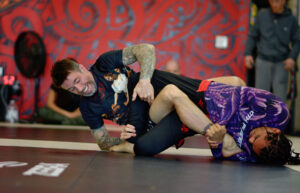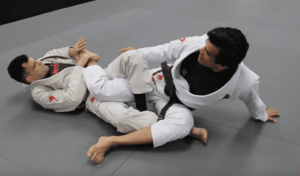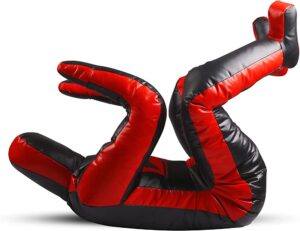Leg locks have been used in various forms of martial arts for centuries, with evidence of their use dating back to ancient Greek and Roman wrestling. However, they have become increasingly popular in recent years due to the rise of MMA and submission grappling competitions.
What is the Honey Hole Position?
The honey hole, also known as the 411 or the saddle, is a position in Brazilian Jiu-Jitsu (BJJ) and submission grappling that allows the practitioner to control their opponent’s leg while also attacking with various submissions. It is a highly effective position that has become increasingly popular in modern grappling competitions.
To enter the honey hole position, the practitioner typically starts in a seated position, often in a butterfly guard or a single leg X guard. From there, they will use their legs and hips to control their opponent’s leg, trapping it between their thighs and knees. This creates a powerful control point that allows the practitioner to attack with a variety of submissions, including heel hooks, knee bars, and ankle locks.
There are several variations of the honey hole position, including the reverse honey hole, the inside honey hole, and the outside honey hole. These variations allow the practitioner to adapt their technique to different situations and opponents.
The reverse honey hole is a variation of the honey hole position where the practitioner switches their grip on their opponent’s leg, controlling it with their opposite leg and freeing up their other leg for attacking submissions. This variation is particularly effective when the opponent is attempting to defend against the honey hole position.
The inside honey hole is another variation where the practitioner controls their opponent’s leg on the inside of their thigh, rather than between their thighs. This allows for greater control of the leg and makes it easier to transition to other positions and submissions.
The outside honey hole, as the name suggests, involves controlling the opponent’s leg on the outside of the thigh. This variation is useful when the opponent is attempting to pass the guard and can be used to sweep them or transition to a more dominant position.
One of the main benefits of using the honey hole position in competition is the versatility it offers. From the honey hole, the practitioner can attack with a variety of submissions and transitions, making it a difficult position to defend against. Additionally, the control offered by the honey hole can be used to slow down the pace of the match and frustrate opponents, leading to mistakes and opportunities for submissions.
The honey hole position is also effective against opponents who are larger or stronger, as it relies on technique and leverage rather than brute force. This makes it an essential tool for smaller practitioners looking to compete against larger opponents.
However, like any submission technique, the honey hole position carries a risk of injury if not applied correctly. It is essential to train with a qualified instructor and to approach the position with caution and respect for your opponent’s safety.
Setups and Entries for the Honey Hole Position

One of the most common setups for the honey hole position is the single leg X guard. From the single leg X guard, the practitioner can control their opponent’s leg and begin to work towards the honey hole position. To enter the single leg X guard, the practitioner will typically use a variety of sweeps or attacks to force their opponent to post their leg, allowing the practitioner to secure the single leg X guard. Once in this position, the practitioner can begin to transition to the honey hole position by trapping their opponent’s leg between their thighs and knees.
Another common setup for the honey hole position is the butterfly guard. From the butterfly guard, the practitioner can use a variety of sweeps and attacks to force their opponent to post their leg, allowing the practitioner to secure the honey hole position. To execute the butterfly guard setup, the practitioner will typically use their legs to control their opponent’s posture, creating opportunities for sweeps and submissions.
In addition to these setups, there are several entries that can be used to transition to the honey hole position from various positions. For example, from the closed guard, the practitioner can use a variety of sweeps and submissions to force their opponent to post their leg, allowing the practitioner to transition to the honey hole position. Similarly, from the knee shield position, the practitioner can use a combination of sweeps and submissions to create opportunities for the honey hole position.
One effective entry to the honey hole position is the “knee cut to honey hole” technique. To execute this technique, the practitioner will typically begin in a standing position and use a knee cut pass to break their opponent’s guard. From there, they will quickly transition to the honey hole position, trapping their opponent’s leg and attacking with submissions.
To successfully execute these setups and entries, it is essential to have a strong understanding of the mechanics of each technique. This requires hours of practice and repetition, both on the mat and through visualization and mental rehearsal. It is also important to be aware of the subtle details and adjustments that can make the difference between success and failure in executing these techniques.
Another key to success in executing setups and entries for the honey hole position is timing. The practitioner must be able to read their opponent’s movements and anticipate their reactions, creating opportunities to execute the technique. This requires a deep understanding of the fundamentals of grappling, as well as the ability to think and react quickly in a dynamic and unpredictable environment.
Attacks and Submissions from the Honey Hole Position

One of the most common attacks from the Honey Hole position is the leg lock. There are various types of leg locks that can be used from this position, including the straight ankle lock, heel hook, and toe hold. To execute a leg lock from the Honey Hole position, the practitioner must control their opponent’s leg by trapping it between their own legs. From there, the practitioner can apply pressure to the ankle, knee, or heel, depending on the type of leg lock they are attempting.
One effective leg lock from the Honey Hole position is the heel hook. To execute a heel hook from the Honey Hole position, the practitioner must first secure their opponent’s leg between their own legs. Next, they will reach back with one arm and grab their opponent’s heel, pulling it towards their own chest. As they do so, they will use their other arm to apply pressure to their opponent’s knee, forcing it to bend in the opposite direction. This creates a twisting motion that can cause significant damage to the knee joint and force their opponent to tap out.
Another effective submission from the Honey Hole position is the calf slicer. To execute a calf slicer, the practitioner will trap their opponent’s leg between their own legs, then use their arm to apply pressure to their opponent’s calf muscle. This can cause significant pain and discomfort, and may force their opponent to tap out in order to avoid injury.
In addition to leg locks and calf slicers, the Honey Hole position can also be used to execute knee bars. To execute a knee bar from the Honey Hole position, the practitioner will control their opponent’s leg between their own legs, then use their arms to apply pressure to their opponent’s knee joint. This can cause significant pain and discomfort, and may force their opponent to tap out in order to avoid injury.
To execute these techniques successfully, it is essential to have a deep understanding of the mechanics of each submission, as well as the ability to read and react to your opponent’s movements. Additionally, it is important to practice these techniques extensively in order to develop the muscle memory and reflexes necessary to execute them quickly and effectively in a live grappling situation.
Escapes and Counters to the Honey Hole Position

One common counter to the Honey Hole position is to use a leg lock of your own. If you find yourself trapped in the Honey Hole, you may be able to turn the tables on your opponent by securing a leg lock on them. For example, you might attempt a toe hold or a straight ankle lock, which can force your opponent to release their own leg lock in order to avoid being submitted.
Another effective counter to the Honey Hole position is to use a kneebar. If your opponent is attempting a leg lock from the Honey Hole position, you can defend against this technique by controlling their knee and using your own leg to apply pressure to their knee joint. This can force your opponent to release the leg lock and may even allow you to transition to a more advantageous position.
If you are unable to counter the Honey Hole position with a leg lock or kneebar, there are a variety of escapes that you can use to break free from this position. One effective escape is to roll away from your opponent and create distance between the two of you. This can allow you to stand up or transition to another position.
Another escape from the Honey Hole position is to use a reverse heel hook. To execute this escape, you must first free your trapped leg by rotating it outwards. From there, you can use your own leg to apply pressure to your opponent’s ankle, forcing them to release the leg lock.
Finally, it is important to remember that the Honey Hole position is not always the best position to maintain. While it can be a powerful tool for launching attacks and submissions, it can also leave you vulnerable to counters and escapes. As such, it is important to know when to transition out of this position and into other positions that may offer more stability and control.
One effective transition from the Honey Hole position is to the 50/50 position. From the Honey Hole, you can release your opponent’s leg and transition to the 50/50, where you can continue to attack with leg locks or work towards a sweep or submission.
Another transition option is to move to the top position. From the Honey Hole, you can release your opponent’s leg and work to establish top control, where you can look to pass their guard or launch attacks of your own.
Drills and Training Tips for the Honey Hole Position

To improve your skills in the Honey Hole position, it’s important to incorporate specific drills and exercises into your training routine. Here are some drills and training tips to help you become more proficient in the Honey Hole position:
-
Static Position Drills: Practice holding the Honey Hole position on a training partner without applying a submission. This will help you learn to control your opponent’s leg and maintain the position for longer periods of time.
-
Dynamic Position Drills: Practice transitioning into and out of the Honey Hole position during live sparring. This will help you become more comfortable using the position in real-life situations.
-
Submission Drills: Practice applying leg locks and other submissions from the Honey Hole position on a training partner. This will help you learn to finish submissions quickly and efficiently.
-
Resistance Training: Use resistance bands or weights to strengthen the muscles used in the Honey Hole position, such as the hips, glutes, and core.
-
Solo Drills: Practice movements that mimic the Honey Hole position on your own. For example, you can practice hip escapes and leg pummeling drills to improve your ability to control your opponent’s leg.
-
Video Analysis: Record yourself practicing the Honey Hole position and analyze your technique to identify areas for improvement.
Incorporating the Honey Hole position into your regular training routine can be an effective way to improve your skills. Here are some tips for incorporating the position into your training:
-
Start Slow: Begin by practicing the position at a slow pace to ensure that you have proper technique and control.
-
Gradually Increase Intensity: Once you feel comfortable with the position, gradually increase the intensity of your training by adding resistance or live sparring.
-
Focus on Control: When practicing the Honey Hole position, focus on controlling your opponent’s leg and maintaining the position rather than immediately going for a submission.
-
Seek Feedback: Ask your training partners and coaches for feedback on your technique and areas for improvement.
-
Be Patient: Becoming proficient in the Honey Hole position takes time and practice, so be patient and persistent in your training.
By incorporating these drills and training tips into your regular routine, you can improve your skills in the Honey Hole position and become a more well-rounded grappler.
By mastering the setups, entries, attacks, and escapes associated with the honey hole position, practitioners can confidently dominate their opponents on the mat. With regular training, drills, and practice, anyone can improve their honey hole skills and take their competition performance to the next level. Remember to check out the video at the bottom of this article for additional guidance on using the honey hole position to dominate in Brazilian Jiu-Jitsu competitions.
Enhance Your Jiu Jitsu Journey with a Grappling Dummy
Are you passionate about jiu jitsu and constantly striving to improve your skills? If so, investing in a grappling dummy could be a game-changer for your training. This versatile tool offers numerous benefits that can elevate your technique and take your grappling prowess to new heights.
First and foremost, a grappling dummy provides an invaluable opportunity for consistent practice. Unlike training partners, dummies are always available, allowing you to train whenever and wherever you want. This convenience eliminates the need to rely on others’ schedules and ensures that you never miss a chance to refine your technique.
Moreover, a grappling dummy enables you to focus on specific moves and positions. Whether you’re perfecting submissions, sweeps, or transitions, the dummy serves as a reliable training partner, allowing you to repetitively practice your desired techniques until they become second nature. This targeted training fosters muscle memory and ingrains the precise movements required for successful execution.
Additionally, a grappling dummy is a safe and controlled training partner. It eliminates the risk of injury during solo practice, ensuring that you can hone your skills with confidence. This is especially beneficial for beginners who may still be developing their control and precision.
Furthermore, a grappling dummy serves as an excellent tool for visualization and experimentation. You can use it to visualize scenarios, simulate realistic opponent reactions, and test out variations of techniques. This creative exploration promotes strategic thinking and adaptability, crucial elements for success on the mats.
Lastly, by purchasing a grappling dummy through my Amazon affiliate marketing link, you not only elevate your training but also support my jiu jitsu blog. As a dedicated practitioner and writer, I strive to provide engaging and informative content to fellow enthusiasts like you. Your purchase through my link allows me to continue creating valuable resources for the jiu jitsu community.
In conclusion, a grappling dummy is a worthwhile investment for any jiu jitsu practitioner looking to take their skills to the next level. Its availability, targeted training capabilities, safety, versatility, and support for visualization make it an indispensable tool in your journey towards mastery. So don’t miss out on this opportunity to enhance your training and support my blog—get your grappling dummy today!
Hey there! Just a heads up that some of the links in this post are affiliate links, which means that if you click on them and make a purchase, I may earn a commission. But don’t worry, it won’t cost you anything extra – in fact, you might even get a sweet deal! Plus, every purchase made through one of these links helps support my blog and keep the content coming. So, if you do decide to make a purchase, thank you so much for your support – it means the world to me!
All the best,
Will



